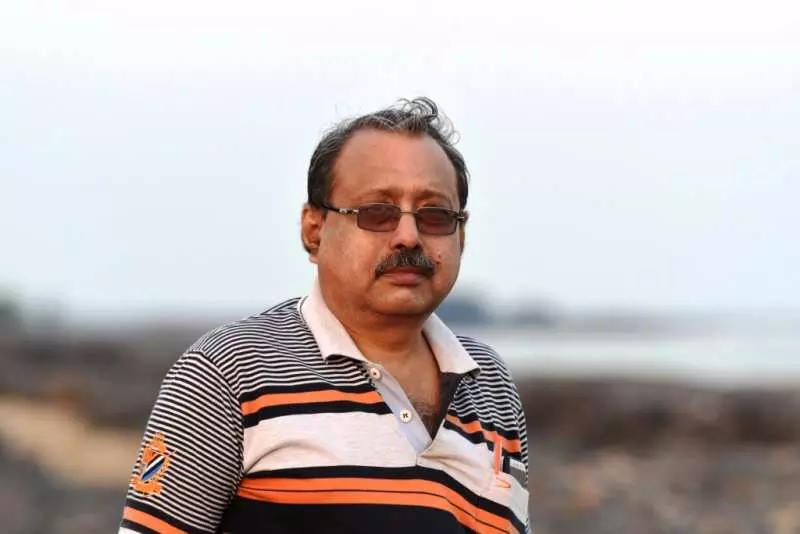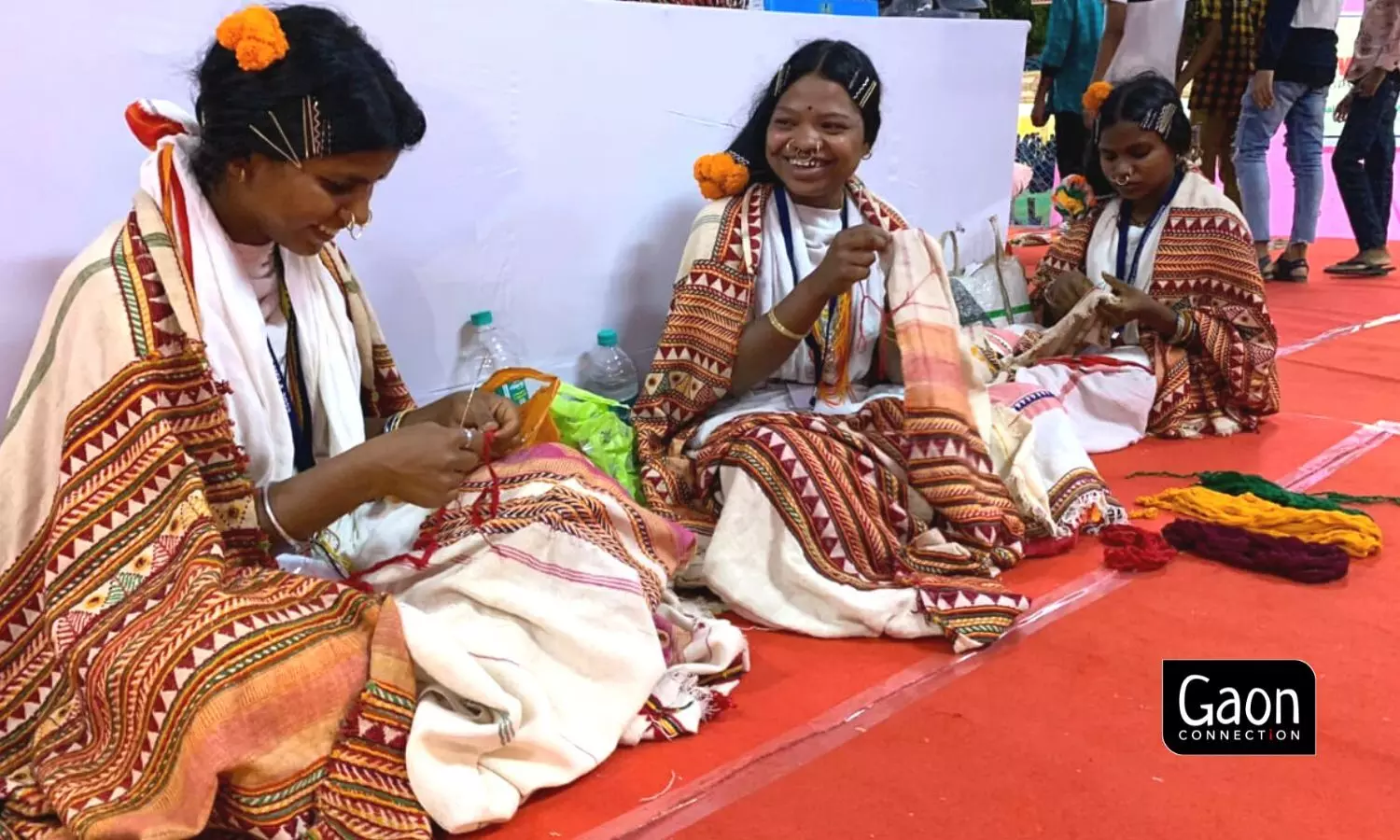The Dongria Kondh tribal women weave an income out of their traditional shawls
While weaving and embroidering shawls with their tribal motifs has been an age-old practice in the Dongria Kondh tribal community in Odisha, it has also become an important source of income for 1,800 tribal women in Rayagada district, as their traditional shawls are being sold far and wide. They now await a GI tag for their labour of love.
 Ashis Senapati 23 Aug 2022 8:08 AM GMT
Ashis Senapati 23 Aug 2022 8:08 AM GMT

The shawls are considered a symbol of love. It takes a weaver two days to complete a shawl, priced around Rs 2,000 each. All photos: Sudrashan Padhy
Maladi Pusika's gnarled fingers do not stop as she embroiders motifs on a traditional shawl. She is one of the thirty women in her village Salapjhola, who weave as part of a self-help group of Dongria Kondh tribe. "Shawl making has been our traditional practice and now we make and sell them," the 49-year-old told Gaon Connection.
The kapada gunda is a shawl that women in the Niyamgiri Hill Ranges in Rayagada district weave and present to those they love, respect and revere. It is an age-old tradition amongst the folk of the Dongria Kondh, a Particularly Vulnerable Tribal Group (PVTG) in the tribal dominated region covering the Bissamcuttack, Muniguda and K. Singhpur blocks in Rayagada district, and in some parts of Lanjigada block in Kalahandi district.
"Weaving has a long tradition in our village and the quality of the shawls are usually very good," Sanari Kadraka from Dhamanpanga village in Rayagada district, told Gaon Connection. The 38-year-old Dongria Kondh added that women between 15 and 60 years of age all weave these shawls. Importantly, now there are at least 1,800 tribal women in the district who earn a livelihood through weaving, she added.
The government-managed Odisha PVTG Empowerment & Livelihoods Improvement Programme provides Rs 3,000 as a stipend to each weaver per month since January 2022, and purchases shawls from them to sell them further. The state government has also started craft fairs in different parts of the state to sell the traditional shawls of the Dongria Kondh tribe, which has brought considerable relief to these weavers.
The traditional shawl of the Dongria Kondh tribal community in Odisha awaits a GI tag that will help its makers earn a better income.
Also Read: Back From The Brink: Maharashtra's Handwoven Ghongadi Blanket
Dongria Kondh tribe
The Dongria Kondh are numerically the largest among the 62 tribes of Odisha. They are known for their famous Meria festival, their colourful attire and their separate language called Kuvi (a Dravidian dialect).
They are expert naturalists with intimate knowledge about the flora and fauna of the region. Around 10,200 Dongria Kondh live in 2,300 households in the picturesque hilly areas of Rayagada district.
"Their culture, way of life and their love for Nature are reflected in the shawls they weave," Sudarsana Padhy, project manager, Dongria Kondh Development Agency (DKDA) that comes under the Odisha PVTG Empowerment & Livelihoods Improvement Programme, told Gaon Connection.
"Generally, green, red, yellow and brown threads are used in the shawls. The green stands for biodiversity, the red represents their religious faith, yellow denotes peace and the brown represents Dharani Penu the goddess, most important to the Dongrias," Padhy explained.
There are three kinds of shawls that the Dongrias make. They are the Sihali Gunda that is used to wrap around the waist; the Ulambi Gunda, that is for the upper torso, and Kapada Gunda, to cover the head. They also have a piece that they tie around in folds around their waists like a belt called Angina Gunda, that comes in handy to tuck away money or any forest produce they may forage while they are out. Both the men and women wear the Kapada Gunda during special occasions.
"This shawl is a symbol of love. I presented it to my husband ten years back when I fell in love with him . Now we are leading a happy married life," Gurati Wadaka, who lives in Arishakani village of Rayagada, smiled.
Post-pandemic shawl promotion
"The impact of the pandemic was severe as many of us were forced to stop weaving," Singari Wadaka of Khajuri village, told Gaon Connection. But now most of the Dongria Kondh weavers are back to their work due to the sustained efforts of the Odisha PVTG Empowerment & Livelihoods Improvement Programme, which is both providing them a stipend and also heping sell their shawls.
"During the pandemic, since the government had put a stop to craft melas, our major source of income had dried up. But now the demand for the shawls has gone up," Maladi Pusika of Salapjhola village said.
The shawls are priced around Rs 2,000 each. It takes a weaver two days to complete a shawl. "We provide the raw materials such as the needles and coloured threads worth Rs 1,000 per shawl to a weaver and she earns around Rs 1,000 for weaving each shawl," Padhy of the Dongria Kondh Development Agency said. The older generation have handlooms in their homes, and the government also provides the weavers with the woven cloth on which the motifs are embroidered, he added.
There are at least 1,800 tribal women in the district who earn a livelihood through weaving.
Also Read: As they sew, so they reap: Women in Bihar use Sujani embroidery to empower themselves
The Dongria Kondh Development Agency also provides training to the weavers under the Ama Parampara-Ama Jeevika (Conserving Culture, Enhancing Livelihood) programme. Under this programme, launched in January 2022, around 110 Dongria women are now getting training from Integrated Tribal Development Agency that also looks after the marketing of the shawls.
"We formed a weaver society namely Niyamgiri Dongria women weavers association," Padhy said. About 5,000 shawls are purchased annually from the 110 women who have been trained. The 30 women of the SHG in Salapjhola of which Pusika is a member, comes under this weavers association too.
The Odisha government has applied for a Geographical Indication (GI) tag for the Kapada Gunda at the GI Registry office in Chennai. A geographical indication tag is used for a product originating from a definite geographical territory. If this shawl gets GI status, its reputation as a unique craft will be enhanced, said Padhy.
"We have established a shawl selling centre and workshop for the weavers at Rayagada. This centre is expected to improve the financial condition of skilled women weavers," Padhy pointed out. This centre also offers an opportunity to tourists to see how the shawls are woven and they can also buy them directly from the weavers.
"After a couple of years of the pandemic, business is picking up. The festival season is knocking at our doors and we are busy weaving shawls," Kachadi Jakesika, a 48-year-old inhabitant of Gandili village, told Gaon Connection.
#odisha #story
More Stories




